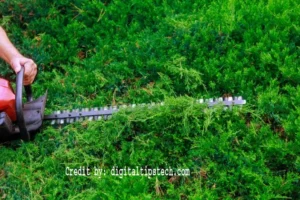How to Plant a Hedge? Hedges serve as natural borders, adding privacy and aesthetic appeal to your outdoor space. Planting a hedge might seem like a daunting task, but with the right guidance, it can be a rewarding and straightforward process. In this guide, we’ll take you through the step-by-step process of how to plant a hedge, from selecting the right plants to ongoing care. Planting a hedge can enhance your landscape’s beauty, provide a living fence, and offer habitat for wildlife. With proper planning and execution, your hedge will thrive for years to come.
Choosing the Right Hedge Plants
Select hedge plants that are well-suited to your climate, soil type, and desired height. Consider factors like evergreen or deciduous varieties and growth rate.

Site Preparation
Clear the area of weeds, rocks, and debris. Ensure good drainage by amending the soil if necessary. A well-prepared site sets the foundation for healthy growth.
Measuring and Marking
Measure the length of your hedge area and mark it out using stakes and a string line. This ensures a straight and uniform hedge.
Digging the Trench
Dig a trench that is twice as wide and as deep as the plant’s root ball. This provides ample space for root development.
Adding Compost and Fertilizer
Incorporate compost and balanced fertilizer into the soil at the bottom of the trench. This provides essential nutrients for initial growth.
Planting the Hedge
Take the plants out of their pots and carefully separate the roots. Place them in the trench at the desired spacing and backfill with soil.

Watering and Mulching
Water the newly planted hedge thoroughly. Apply a layer of mulch to control moisture, suppress weeds and maintain soil temperature.
Pruning and Shaping
Prune the hedge after its first flush of growth to encourage bushier growth. Pruning on a regular basis is essential for preserving the desired shape.
Pest and Disease Management
Keep a close watch on the hedge for any indications of pests or diseases. Take immediate action if you observe any problems to contain their spread.
Regular Maintenance
Water the hedge regularly, especially during dry spells. Apply a slow-release fertilizer in spring to support healthy growth.
Advantages of Hedges
Hedges offer natural beauty, noise reduction, and habitat for birds and beneficial insects. They can also increase property value.
What is the best time to plant hedges?
The best time to plant hedges can vary depending on the specific type of hedge plant you’re working with and the climate of your region. However, there are generally two optimal planting seasons for most hedge plants: fall and spring.

Fall Planting (Late Summer to Early Fall): This is often considered the best time to plant hedges because the weather is cooler and there’s usually ample moisture in the soil. Planting in the fall gives the roots a chance to establish themselves before winter sets in, which can lead to healthier growth the following spring. Aim to plant your hedges about 4-6 weeks before the first expected frost.
Spring Planting (Late Winter to Early Spring): Spring is also a suitable time for planting hedges. As the weather warms up and the soil thaws, plants have a chance to establish their root systems before the hotter summer months. However, planting in spring might require more consistent watering to ensure the new plants have enough moisture.
Keep in mind a few important tips:
Soil Conditions:
Make sure the soil is well-prepared with good drainage. If the soil is too wet or too dry, it can stress the new plants. So the carefully follow soil conditions.
Spacing:
Plant your hedge plants at the appropriate spacing to ensure proper growth and coverage. This might require some research specific to the plant species you’re using.
Mulching:
Mulching is a important parts for this project. Must Apply mulch around the base of the plants can help retain moisture, suppress weeds, and regulate soil temperature. It is effective process and it is good practice for plants.
Plant Selection:
Plant selection is the most important part. Hedge plants are very sensitive, because easily attack many type of diseases. Choose hedge plants that are suitable for your climate, soil type, and the amount of sunlight the planting location receives.
After Care Hedge Plant:
After planting, keep an eye on the plants for signs of stress or disease. Prune as necessary to encourage vigorous growth. If you’re unsure about the best time for planting specific hedge plants in your area, it’s a good idea to consult with local gardening experts, nurseries, or agricultural extension offices Receive personalized recommendations specific to your area’s climate and conditions.
How can I calculate the appropriate number of plants for a hedge?
It is common type of questions. The necessary amount depends on various elements such as plant type, desired dimensions, and spacing or land area.
As a rough guideline, here’s what you might consider:
Spacing:
The spacing between plants can vary, but for many hedges, a common guideline is to plant them at a distance of about 1/2 to 2/3 of their mature width. So, if the mature width of your chosen hedge plant is around 3 feet, you might plant them about 2 feet apart.
Height:
The height you want the hedge to be also impacts the spacing. Taller hedges may require more space between plants to avoid crowding as they grow.
Plant Type:
Different plants have different growth habits, so it’s important to consider the specific characteristics of the plants you’re using. Some plants naturally have a dense growth pattern, while others might require more plants to achieve a solid hedge.
Speed of Growth:
If you’re looking for a quicker fill-in, you might opt to plant the plants closer together.
Maintenance:
Regular pruning can help control the density of the hedge. If you’re willing to put in the effort to regularly trim and shape the hedge, you might be able to space the plants a bit farther apart.
Local Conditions:
The local climate, soil type, and other environmental factors can also influence the spacing and the number of plants needed.

Given these considerations, it’s best to consult with local nurseries, gardening experts, or resources specific to your area for more accurate guidance. They can provide recommendations based on the specific plants you’re using and the conditions in your location.
What is the quickest growing hedge?
The Leyland cypress (x Cupressocyparis leylandii) is often considered one of the fastest-growing hedge plants. It is a hybrid between the Monterey cypress and the Nootka cypress. Leyland cypress is known for its rapid growth rate, making it a popular choice for creating privacy screens or hedges in a relatively short amount of time. However, its quick growth can also lead to maintenance challenges, as it may require frequent pruning to keep its size in check and maintain a desired shape. Keep in mind that while Leyland cypress can provide quick results, it’s important to consider factors such as soil conditions, climate, and maintenance requirements when selecting a hedge plant.
FAQs
Can I plant a hedge in any season?
While the best time is typically fall or spring, you can plant hedges in mild climates during winter too.
How far apart should I space the plants?
Spacing depends on the plant’s mature size. Abide by the advised spacing guidelines to achieve optimal growth.
What tools do I need for hedge planting?
Common tools include a spade, pruning shears, gloves, and a watering can.
How tall can I expect my hedge to grow?
This varies by plant type. Research the mature height of your chosen species.
How often should I prune the hedge?
Regular pruning every few months during the growing season will help maintain its shape.
Planting a hedge is a gratifying endeavor that adds beauty and function to your outdoor space. With proper planning, planting, and maintenance, you can create a lush, vibrant hedge that enhances your landscape for years to come.
Finally Some Quote:
Planting a hedge requires careful planning and attention, but the results are well worth it. Your hedge will flourish as a testament to your efforts. I think if you maintain or applied this technique, your hedge plant project must success without any hesitation.